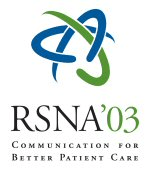
Abstract Archives of the RSNA, 2003
Kun Cheng Li MD, PRESENTER: Nothing to Disclose
Abstract:
HTML
Purpose: To evaluate the value and limit of CT plain scan, CT cerebral perfusion imaging and transcranial Doppler(TCD) in transient ischemic attacks (TIA).
Methods and Materials: Conventional CT, CT cerebral perfusion imaging and TCD were performed in 20 patients with TIA diagnosed by clinical. Conventional CT and CT cerebral perfusion imaging were performed on 20 patients with TIA diagnosed by clinical. After regular CT examination (Siemens, Somatom Plus 4, 10mm thickness, 10mm gap) dynamic scans of 40 seconds were performed on selected slice (usually on the basal ganglia slice), while 40ml non-ionic contrast material were bolus injected through antecubital vein with Medrad CT injecting system. These dynamic images were processed with the Siemens Perfusion CT software package on a PC based workstation. Cerebral blood flow (CBF) and time to peak (TTP) enhancement were measured within specific regions of the brain on CT perfusion images. Quantitative analysis was used for these images. TCD were performed(Medasonic CDS,USA)on 20 patients with TIA , peak-systolic velocity (PSV),end-diastolic velocity (EDV) ,mean velocity (MV) and pulsation index (PI) were measured. The results of CT plain scan, CT cerebral perfusion imaging and TCD were analysed in comparison way.
Results: The head plain scan of CT could excludes other intracerebral diseases,and perfusion CT provides valuable hemodynamic information and shows the extent of perfusion disturbances, however, TCD could demonstrates involved cerebral arteries for patients in TIA. In 20 cases of TIA, conventional CT were normal, however persisting abnormal perfusion changes corresponding to clinical symptoms were found in 13 cases with prolonged TTP. Other 7 cases were normal. TTP of affected side (11.6±3.0s )was compared with contrast side (8.8±1.5s )significantly prolong ( t=4.782,P<0.01). The difference of the CBF was not statistically significant (t=1.912,P=0.073) between affected side (223.9±19.6 ml. min-1.L-1) and contrast side (227.7±19.8 ml. min-1.L-1). The findings of TCD were severe stenosis or occlusion of the carotid artery with 10 patients, arteriosclerosis with 6 patients, fall of blood speed with 2 patients, vasospasm with 1 patient.
Conclusion: The combination of these three imaging methods could obtain more diagnostic information, and the information can play an important role in the diagnosis and treatment of TIA.
Questions about this event email: LUCY_LJ1124@YAHOO.COM
Li MD, K,
Primary Study of Comparative Imaging in Transient Ischemic Attacks. Radiological Society of North America 2003 Scientific Assembly and Annual Meeting, November 30 - December 5, 2003 ,Chicago IL.
http://archive.rsna.org/2003/3104413.html

